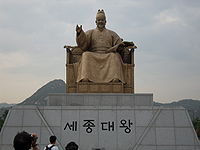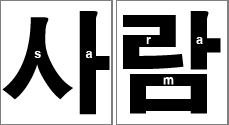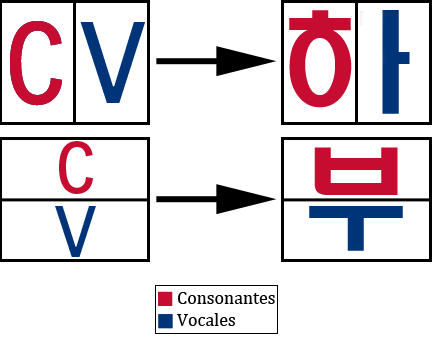Hangeul step 1/es
|
|
| Ayuda · Chuleta · Portal de la Comunidad |
Introducción

Seokjin and Kyoung-eun: Steps 4, 5, 6
http://www.talktomeinkorean.com
Bienvenidos. A diferencia del japonés y el chino, las bases de la escritura coreana se pueden aprender en cuestión de horas. La única manera de pronunciar con precisión palabras coreanas es usar su escritura, Hangeul (한글). Español y coreano no tienen sonidos exactamente iguales, así que usar la romanización es antes que nada una mala idea. En las siguientes páginas hemos diseñado un plan de lecciones de seis pasos y hemos empleado varios métodos para ayudar a otros a que aprendan la escritura coreana rápida y efectivamente. Este es un proyecto en conjunto entre Korean Wiki Proyect y TalktomeinKorean.com. Hemos estado buscando por las voces correctas que representen los sonidos del Hangeul y han dado tiempo voluntariamente de su ocupado horario para seguir adelante con el proyecto. Estamos muy agradecidos por su esfuerzo y su apoyo.
Un séptimo paso será creado en el futuro para ayudarle con la pronunciación avanzada.
Brief History
See full article at The Origin of Hangeul


Hangeul was introduced under Sejong the Great and finished around 1444. Up until and even after that time, Chinese characters were used as the written language, limiting reading and writing to the royal and government elite. King Sejong wanted Korea to have its own script that could be easily learned by anyone -- even commoners. After its creation, Hangeul was said to be easy enough to learn that a wise man could finish it in the morning and a fool could finish it by night. For this reason there was opposition to Hangeul for a time by Korean aristocrats, believing only those of social superiority should have this special privilege.
Ever since Hangeul was first introduced, it has gone through many phases of refinement. Korean went through a large reformation during the Japanese colonization in the early 1900's, removing many of the now-archaic letters and changing several rules.
Hangeul is considered easy to learn by many people because most of the similar shaped letters have a similar sound as well, making it easy to see the relationship and making it easy to memorize.
Basics
Consonants
There are 14 basic consonants in Korean and five double consonants which are formed from the basic consonants ㄱ, ㄷ, ㅂ, ㅅ, and ㅈ respectively.
| Basic consonants | 
|
| Double consonants |
Vowels
There are eight basic vowel sounds along with 13 other complex vowel sounds. These complex vowels are called diphthongs, which are combinations of no more than two vowels. Whereas multiple vowels are normally voiced in separate syllables, each vowel composing a diphthong is voiced together within one syllable. As you can also see just from looking, most diphthongs are combinations of two basic vowels.
All basic vowels are created by three types of strokes. The first stroke symbolizes Heaven and is a dot (•), though in modern Korean this dot is just a simple, short stroke. The next type of stroke symbolizes earth and is a horizontal line (ㅡ). The final stroke symbolizes man (ㅣ). These symbols are combined to create the Korean vowels, for example | plus • makes ㅏ.
| Basic vowels | 
|
| Complex vowels | 
|
Syllable Blocks
Korean words are written from left to right and words are formed by writing each syllable in a block-like shape. Each letter inside the block forms a sound. The word for 'person' is 사람, romanized as 'saram,' and consists of two syllables. The letters ㅅ + ㅏ make the syllable block of 사 ('sa'), while ㄹ + ㅏ + ㅁ make the next syllable 람 ('ram'). The picture below will show you a sound approximation of each of the Korean sounds contained in the word. Also note that written Korean doesn't actually draw boxes around the syllables, this is just for illustrative purposes.

Korean syllables are organized into blocks of letters that have a beginning consonant, a middle vowel, and an optional final consonant. A syllable block is composed of a minimum of two letters, consisting of at least one consonant and one vowel. In our lesson plan, Steps 2, 3 and 4 will focus on just words with a consonant and one horizontal vowel, and words with a consonant and one vertical vowel (see below). Step 5 will introduce the final consonant concept and step 6 will show syllables that can consist of double vowels.

Also note if you want to write only a vowel, it must be written with the consonant ㅇ, which acts as a silent placeholder for the consonant position. Why? Think of the ying and the yang concept. If one wants to write the vowel ㅏ, they would have to write it as 아 with ㅇ being a silent placeholder for the consonant position. An easy way to remember this is to think of the ㅇ as a zero. More examples below:
| Original vowel | Written by itself |
|---|---|
| ㅏ | 아 |
| ㅐ | 애 |
| ㅓ | 어 |
| ㅔ | 에 |
| ㅗ | 오 |
| ㅜ | 우 |
| ㅡ | 으 |
| ㅣ | 이 |
Writing
As already mentioned, Korean words are written from left-to-right and top-to-bottom in block-like forms. In the next few sections you will learn how to write each letter and its appropriate stroke order. While stroke order may not seem important at first, it is important when writing Korean naturally and helps others to be able to read your handwriting. The shapes and size of the letters can be stretched or compressed to fill in the block space and to make it evenly sized with other all other syllables. In the example below, you can see how the size and shape of the letter ㄱ changes to fill in this imaginary block (highlighted in sky blue).

Now we are going to start learning some letters, which are called jamo. Please note that, in order to view these lessons in their entirety, you must have Adobe Flash Player installed. This will allow you to play all included audio files on the following pages. Don't worry, you more than likely have it installed on your computer already.

|
